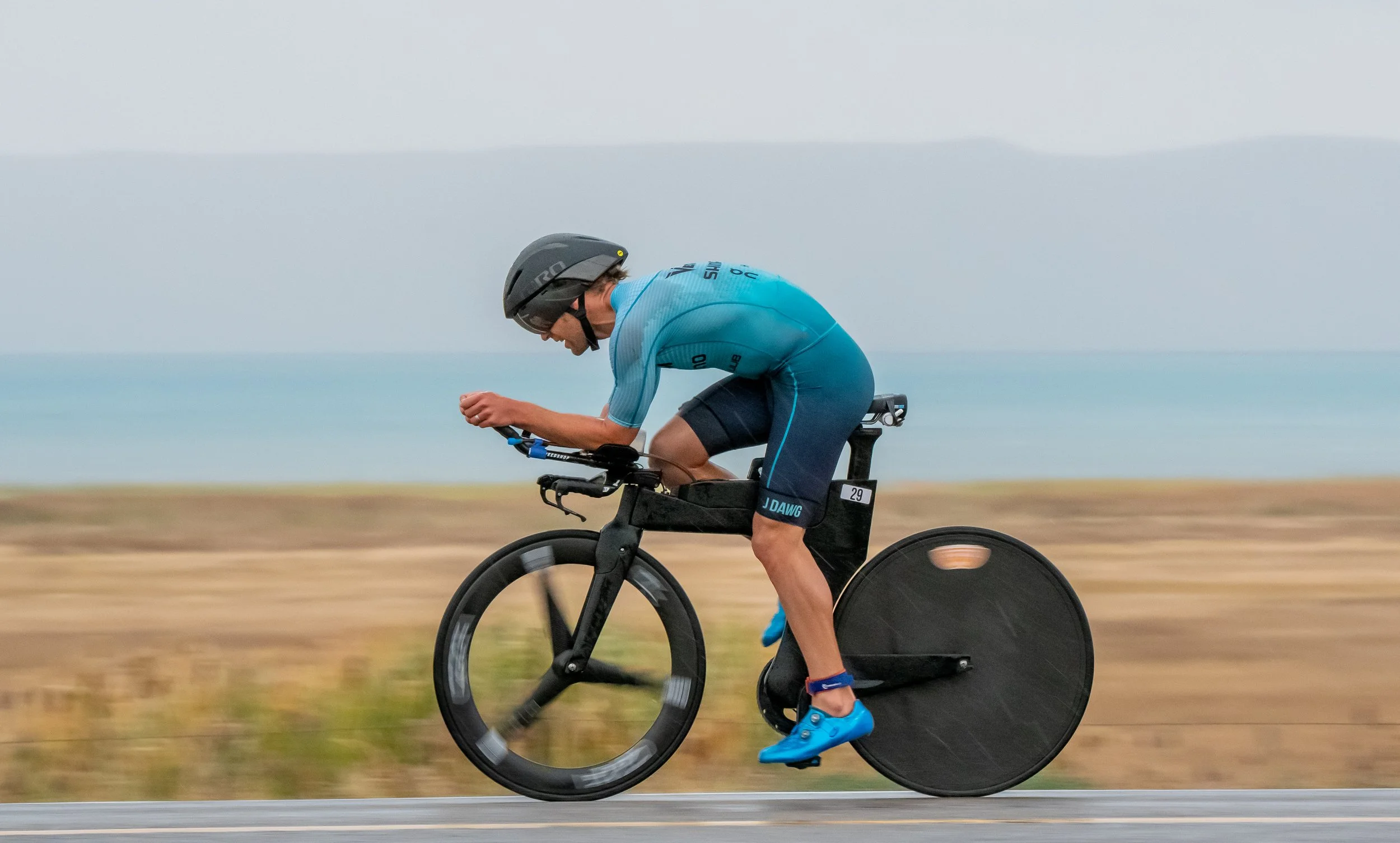The Performance Equation
Riding in the pouring rain near the Idaho/Utah border. Photo by Paul Higgins.
In 2009, Bobby McGee and I were having a conversation around the pursuit of peak performance which led him to introduce me to his theory of the 90/9/1% Principle.
According to McGee, he found that athletes tended to fall into one of three categories:
The 90: 90 percent of athletes perform at a level that is “below their predicted performance based on training and trials.”
The 9: Nine percent of athletes perform in line with the level of their training.
The 1: One percent of athletes perform above/beyond the level of their training.
I cannot speak to the specifics of how McGee landed on these exact numbers, but regardless of any hard numbers, I think its constructs are more about understanding the performance gaps that are often seen amongst so many athletes. When McGee told me about this principle, it really resonated with me as I had seen and experienced much of what he described. Furthermore, when contemplating the disconnect between one’s training and subsequent performance, McGee suggested that the bridge lies within the mind (not his exact words, but my interpretation of them).
As I thought more about this idea over the years, I began to think of this principle in more fluid terms. In other words, I felt that we are all simultaneously a 90% and a 9% and a 1% athlete, but the more we can learn how to operate in the nine, the more chances there are of having those magical, transcendent one percent moments in our athletic careers. (I alluded to this idea in the article Most Days Are Just Days).
Fast forward to 2025.
Earlier this year, I was asked to formally present my ideas (in school) around performance (and its breakdowns) when analyzing it through a performance psychology lens. Nearly 16 years since first speaking with McGee, his principle still influences my thinking and it led me to conceptualize performance in what I call, the performance equation. Traditionally, I think many athletes tend to see performance as coming from an equal input:output equation that looks something like:
Preparation = Performance
This line of thinking tends to suggest that if we put in the right amount of training, recovery, work, etc. that it will deliver a proportionate performance commensurate with the input.
Instead of suggesting this equation is incorrect, I like to think of it as incomplete. This has led to my addition of two components to create the following performance equation:
Preparation + Opportunity + Execution = Performance
With the addition of opportunity and execution, I believe it gives a deeper insight into understanding what performance entails. Now let’s break down each component.
Preparation
The first component is preparation. This is the piece that is likely to be the most obvious to all of us. This involves physical training, development and mastery of physical and mental skills, optimizing recovery, race course and competitor reconnaissance, environmental demands (e.g., heat or altitude acclimatization), and anything else that helps the body and mind prepare for what is to come. This is not an exhaustive list so do not discard anything that I failed to mention.
Before moving on, I want to emphasize one point about preparation. There cannot be excellent performance without excellent preparation. There are no shortcuts or hacks to peak performance.
However, someone can be well prepared and fail to perform.
Let’s imagine two students both fail an exam at school. One student studied, but got flustered during the exam, continuously second-guessed their work, and subsequently failed the test. The other student that failed the test never opened a book and never prepared for the exam.
Both students have the same initial performance, but only one has the potential to improve based on their level of preparedness.
Opportunity
The second component of the equation is opportunity. This component may be less obvious to us and consists of a few different factors as I see it.
First, opportunities are not guaranteed.
As I am sure that many (most) people reading this article likely come from an endurance sports background, this may not appear as salient, but let’s think about it from a team sport like American football. The second string quarterback spends every week preparing for each weekend’s game, but may never get the opportunity to play.
When thinking about this in other contexts, what if a race gets cancelled on race day for weather? What if your flight gets cancelled and you cannot get to the race? What if a pandemic occurs and an entire season gets cancelled?
All this is to say, we have to have the opportunity to compete/race in order to perform. You can have the greatest preparation in the world, but you also need to have the opportunity to showcase it. I think when athletes can better appreciate that opportunities are never guaranteed, it can lead to a better appreciation for each chance they have to perform.
Moreover, it is essential to understand that all opportunities are unique. While some may be similar, they are never repeated.
Second, opportunities should be, but are not always, embraced by athletes.
This gets to the basic idea of whether an athlete is looking forward to their chance to perform or if they (unknowingly or knowingly) fear it. Going one step further, for the athletes that love to prepare, do they equally love to compete? (There can be a lot to unpack in these last couple sentences, but for now I will leave it at that).
Finally, fitness heuristics (e.g., test sets or benchmark workouts) may suggest the opportunity for performance, but not the guarantee of it.
A number of years ago, I wrote an article for Endurance Corner about how to train to run fast off the bike in a triathlon. I covered some workouts and other concepts, but just before I finished I added a final point I wanted everyone to remember: Just because you did all these workouts does not mean you will run fast off the bike, it only means that you may have the opportunity to run fast off the bike.
This is where fitness heuristics can come into play and it gets back to my original thoughts around the incomplete equation of preparation = performance.
For example, a run coach may use a standard test set of 10 x 400/1:00 rest in order to predict someone’s performance on the track when racing the mile. Let’s say some really fast athlete runs 60” for each quarter in the workout, which would predict a 4:00 mile in their upcoming race. In this case, the athlete may have the fitness that will give them the opportunity to run a 4:00 mile, but not the guarantee of it.
I think when athletes lean too heavily into the predictability of these types of benchmark sessions, it can result in a sense of complacency that has the athlete believing the upcoming results of a competition are somewhat of a foregone conclusion.
Execution
The third, and final, component of the performance equation is execution. Much like preparation, I think execution is something that easily resonates with many of us. Once an athlete has prepared and has been offered an opportunity to compete, they then have to execute their plan to perform.
While the tactics and strategies may differ based on individual approaches to competition, it will almost always involve a goal of trying to access the highest percentage of one’s fitness and skills at the moments when it matters most. That said, I do think that what each athlete has available to them when they compete is not static, so extracting the most out of oneself based on what is available that day is the more critical component of effective execution. (Again, see Most Days Are Just Days).
When it comes to assessing performance, execution is often the area of primary focus when trying to understand any disconnect that may exist between one’s training and racing. However, I think when execution becomes the sole area of focus, it can lead to missing the big picture. For example, a team that suffers a crucial loss on the final play of the game can become overly focused on how to correct that specific moment instead of looking at the totality of the performance.
Finally, particularly when operating in the world of endurance athletics, I think that extracting the most out of oneself during competition has to be derived from something deep within each of us.
Before a competition, it can be easy to think of the benefits of an outcome, be it a PR, a placing, prize money, becoming a champion, etc., but once the discomfort and stress builds, the external factors/rewards matter less and one’s internal drive (sometimes called one’s “Why”) matters most. In my opinion, as an athlete better understands that drive, the better they will become at staying present, executing their plans, and delivering peak performances.
Put it altogether and you have:
Preparation + Opportunity + Execution = Performance
+++++++++++++++++++++++++++
Moving forward, I will be expanding on different aspects within the performance equation. If you all have any preferences for areas to expand upon, please feel free to contact me HERE. Thanks for reading.
-j
A deceivingly windy day on the cliffs between Folkestone & Dover, UK.

